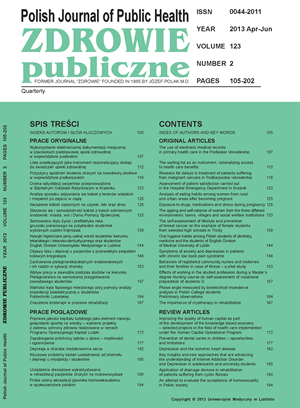Exposure to drugs, medications and stress during pregnancy
DOI:
https://doi.org/10.12923/j.0044-2011/123-2/a.06Keywords:
attitudes of pregnant women , alcohol, smoking, drugs , stress, work conditionsAbstract
Introduction. Literature provides much evidence of negative effects of alcohol, nicotine, or drugs in pregnancy. There are also data indicating the relationship of stress and physical work with many complications during this period.
Aim. The aim of the study was to assess the exposure of pregnant women to tobacco smoking, alcohol, stress, exercise, medications, and analysis of their awareness and knowledge on the subject, indicating the high-risk groups.
Material and methods. The study was conducted in August and September 2012 in gynecology and obstetric clinics in Lublin with 138 pregnant women. A questionnaire containing 26 questions was a proprietary research tool.
Results. In the study group, 25.3% of women were exposed to harmful tobacco compounds in the first trimester. Smoking was observed statistically more often among young women and the women exposed to high stress. Every fifth woman has abnormal knowledge of alcohol use observed significantly more often among women with unplanned pregnancy, young and under high stress level. Fifty per cent of economically active participants were performing physical work during pregnancy and 20.2% were exposed to high stress, which correlated significantly with higher education and performed “desk job”. Every fourth respondent among half of the respondents who use the self-treatment in case of complaint would apply NSAIDs.
Conclusions. Lack of knowledge and awareness of pregnant women make them reach for harmful substances. Some pregnant women perform heavy physical work as well as are exposed to stress, which results in more frequent recourses to drugs. Some drugs are often seen as safe and accepted by pregnant women without consulting a doctor.
References
1. Biernacka J, Hanke W. Wpływ stresu psychospołecznego w pracy zawodowej i pozazawodowej na przebieg i wynik ciąży. Med Pr. 2006;57(3):281-90.
2. Muszalik M, Marzec A, Kartuzi Z. Edukacja zdrowotna metodą zapobiegania palenia papierosów i piciu alkoholu wśród młodzieży szkolnej. Pielęg Pol. 2005;2:225
3. Salmasi G, Grandy R, Jones J, McDonald S. Environmental tabacco smoke exposure and perinatal outcomes reviews and meta-analyses. Acta Obstet Gynecol Skand .2010;89;423-41.
4. Wisborg K, Kesmodel U, Henriksen TB, et al. Exposure to tobacco smoke in utero and the risk of stillbirth and death in the first year of life. Am J Epidemiol. 2001;154(4):322-7.
5. Goodwin RD, Keyes K, Simuro N. Mental disorders and nicotine dependence among pregnant women in the United States. Obstet Gynecol. 2007;109(4):875-83.
6. Kesmodel U, Wisborg K, Olsen SF, et al. Moderate alcohol intake during pregnancy and the risk of stillbirth and death in the first year of life. Am J Epidemiol. 2002;155(4):305-12.
7. Brus R, Sokoła A. Leki a ciąża. Elementy farmakologii pediatrycznej. In: W Kostowski, ZS Heraman. Farmakologia. Podstawy farmakotera¬pii. Warszawa: PZWL; 2010. p. 682-91.
8. Bińczycka T. Ochrona kobiet w ciąży i w okresie macierzyństwa w prawie wspólnotowym i w polskim ustawodawstwie pracy. PiZS.1998;5:13-22.
9. Raport Ministerstwa Zdrowia.. Stan zagrożenia epidemią palenia tytoniu w Polsce. 2010. [http://www.mz.gov.pl/wwwfiles/ma_struktura/docs/raport_epidemia_16082010.pdf]
10. Szymborski J, Borkowski W, Ołtarzewski M, et al. Epidemiologia i zdrowotne następstwa biernego palenia tytoniu. In: J. Szymborski, T. Laskowska-Klita, J. Mazur (ed). Zdrowie naszych dzieci. Dzieciństwo wolne od tytoniu. Warszawa: ALUNA; 2001. p. 109-25.
11. Gilman SE, Breslau J, Subramanian SV, et al. Social factors, psychopathology, and maternal smoking during pregnancy. Am J Public Health. 2008;98(3):448-53.
12. Tough S, Tofflemire K, Clarke M, Newburn-Cook C. Do women change their drinking behaviors while trying to conceive? An opportunity for preconception counseling. Clin Med Res. 2006;(4):97-105.
13. Rybus-Potęba E, Marczewski K. Samoleczenie – stare zagrożenia czy nowy świat pomocy dla pacjenta. Zdr Publ. 2001;111(1):31-6.
14. Biernacka JB, Hanke W, Makowiec-Dąbrowska T, et al. Psychospołeczne uciążliwości środowiska pracy zawodowej kobiet ciężarnych a ryzyko występowania porodu przedwczesnego. Med Pr. 2007;58(3):205-14.
15. Mozurkewich EL, Luke B, Avni M, Wolf FM. Working conditions and adverse pregnancy outcome: A metaanalysis. Obstet Gynecol. 2000;95(4):623-35.


